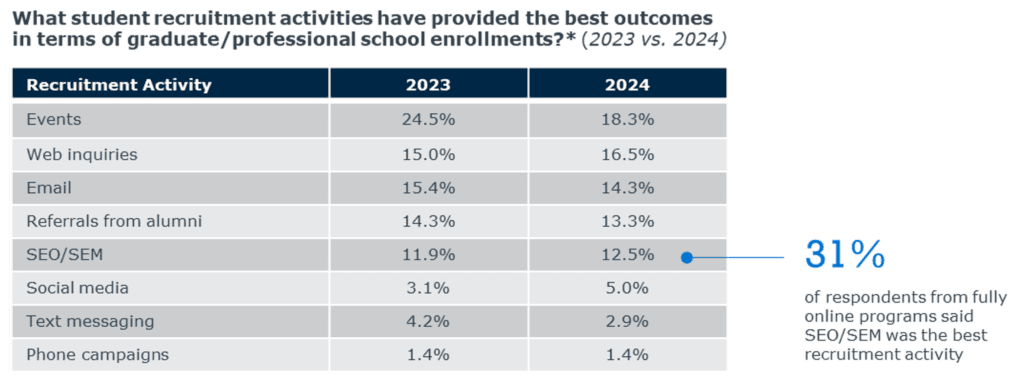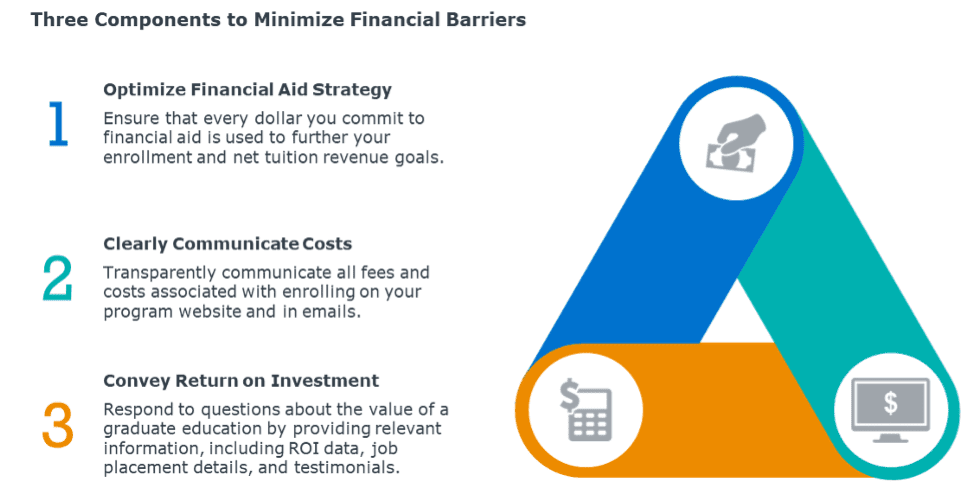Graduate students are changing – are your recruitment tactics keeping up?
Enrollment teams know best that as technology and students change, so must the marketing and recruitment tactics to reach them. The entrance and expansion of Gen Z in the graduate market is one such change. The growth of independent research, leading to 80% of prospects being unknown to the institution prior to applying, is another. Despite these market headwinds, our recent survey revealed that the majority of graduate enrollment leaders saw their headcount and revenue goals increase. But nearly 40% of graduate programs in our survey did not meet their enrollment goals. To meet growth goals and stay competitive, enrollment teams will need to develop nimble marketing strategies and messages that will appeal to their future graduate students.
To learn more about how these changes are impacting graduate enrollment teams’ recruitment strategies, our Adult Learner Recruitment team partnered with NAGAP, The Association for Graduate Enrollment Management, to survey 200+ enrollment leaders across the country in early 2024. Here are three key findings from the survey and related strategies that your graduate enrollment team can implement to improve your marketing and recruitment strategies.
Explore the full survey findings
1. Graduate leaders’ top priority is to communicate the value of a graduate education
“Communicating the value of a graduate degree” is the top priority for surveyed graduate enrollment leaders. As we found in our survey of graduate students and adult learners, students increasingly make enrollment decisions based on cost, with financial aid ranking as the top factor influencing enrollment decisions. One way to communicate the value of a graduate degree is to highlight program affordability and financial aid opportunities.
“Maintaining a robust website for prospective students” was nearly tied for the top priority, which is of course one channel where it is especially important to communicate clearly and effectively. In the same survey of adult learners, 93% said they visit the websites of all the schools or programs they are considering.
Strategy: Given the growing cost-consciousness of prospective students and the importance of websites as a recruitment tool, marketing and enrollment teams need to invest in user-friendly websites that clearly display need-to-know information.

2. Events, inquiries, and emails provided the greatest recruitment impact
Recruitment events provided the best enrollment outcomes for surveyed graduate and professional schools and were especially effective for in-person programs (30.6%) compared to hybrid (16.8%) and online programs (15.4%). However, the impact of events declined by 25% overall compared to last year, while the impact of web inquiries, SEO/SEM, and social media on recruitment and enrollment grew in that time.

Strategy: Because there was a much smaller gap between the effectiveness of the top recruitment activities this year, it is incredibly important to have a diversified lead strategy that leverages several channels. A one-size-fits-all approach to reaching and enrolling graduate students will no longer suffice. To craft emails, social media ads, and other content that will resonate most with prospective students, consider adopting intent-based marketing, which relies on personalization and real-time response, to reach students with the right messaging at the right moment in their journey to enrollment.
See how one grad school used intent marketing to nearly triple online enrollment in three years
3. Graduate enrollment teams are most concerned about fiscal trends
To understand how graduate enrollment leaders feel about emerging trends such as new AI, growing competition from the job market, and decreasing university budgets, we asked respondents to label trends as positive or negative influences on graduate enrollment over the next three to five years. Surveyed graduate enrollment leaders expressed the most concern about the negative impact of trends related to university finances. As noted earlier, the increasing cost of higher education and students questioning the value of higher education are two big concerns for students and enrollment teams alike. The other two financially related concerns include a decrease in university budgets and a decrease in federal funding for graduate education.
Strategy: Year over year, one of the biggest factors driving graduate students’ enrollment decisions is cost, including financial aid, scholarships, and tuition and fees. To empower prospects to enroll, you’ll need to give them confidence that your program can help them achieve their professional goals—without breaking the bank.

These survey results underscore that there is no magic bullet to recruiting graduate students. What works for one program may not work for another, and what works now may not work a few years from now. Is your graduate enrollment team ready to meet changes in the market with a student-centric, efficient, and adaptable recruitment strategy?

More Blogs

4 questions domestic students will ask before applying to your graduate program

EAB Wrapped 2025: A year of reckoning—and reinvention—in higher ed
